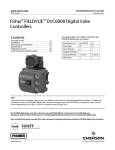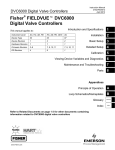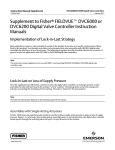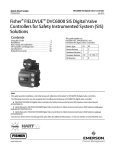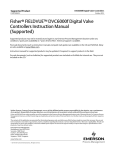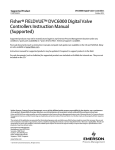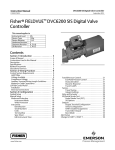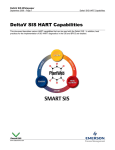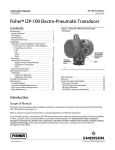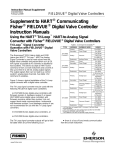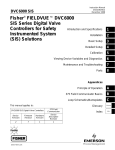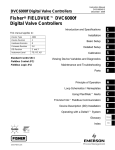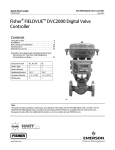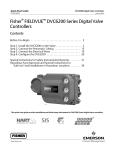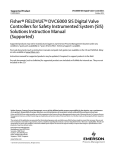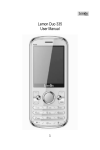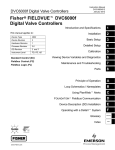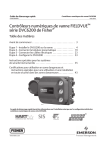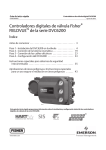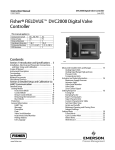Download to the PDF file.
Transcript
Quick Start Guide DVC6000 Digital Valve Controller D102762X012 July 2013 Fisherr FIELDVUE™ DVC6000 Digital Valve Controllers Contents Using this Guide . . . . . . . . . . . . . . . . . . . . . . . . . . . 2 Installation . . . . . . . . . . . . . . . . . . . . . . . . . . . . . . . 4 Basic Setup and Calibration . . . . . . . . . . . . . . . . . 25 Specifications . . . . . . . . . . . . . . . . . . . . . . . . . . . . 34 Related Documents . . . . . . . . . . . . . . . . . . . . . . . 37 Loop Schematics and Nameplates . . . . . . . . . . . 39 This guide applies to DVC6010, DVC6020, and DVC6030 digital valve controllers: Instrument Level AC, HC, AD, PD HC, AD, PD Device Type 03 03 07 Device Revision 1 2 2 Hardware Revision 1 1 1 Firmware Revision 2-6 7, 9 ,10, 11 7, 9, 10, 11 DD Revision 4 8 1 AC Note This guide provides installation, initial setup, and calibration information for DVC6000 digital valve controllers. For additional information, refer to the DVC6000 digital valve controllers instruction manual (D102794X012), available from your Emerson Process Management sales office, or from our website at www.FIELDVUE.com. The DVC6000 digital valve controller instruction manual (D102794X012) can be found at www.FIELDVUE.com http://www.documentation.emersonprocess.com/groups/public/documents/instruction_manuals/d102794x012.pdf Refer to Related Documents on page 37 for other documents containing information related to DVC6000 digital valve controllers www.Fisher.com Quick Start Guide DVC6000 Digital Valve Controller D102762X012 July 2013 Product Description DVC6000 digital valve controllers (figure 1 and 2) are communicating, microprocessor‐based current‐to‐pneumatic instruments. In addition to the traditional function of converting an input current signal to a pneumatic output pressure, the DVC6000 digital valve controller communicate via HARTr protocol. DVC6000 digital valve controllers are designed to directly replace standard pneumatic and electro‐pneumatic valve mounted positioners. Do not install, operate, or maintain a DVC6000 digital valve controller without being fully trained and qualified in valve, actuator, and accessory installation, operation, and maintenance. To avoid personal injury or property damage, it is important to carefully read, understand, and follow all contents of this quick start guide, including all safety cautions and warnings. If you have any questions about these instructions, contact your Emerson Process Management sales office before proceeding. Figure 1. FIELDVUE DVC6010 Digital Valve Controller Mounted on a Fisher Sliding‐Stem Valve Actuator Figure 2. Fisher Rotary Control Valve with FIELDVUE DVC6020 Digital Valve Controller W9418 W7957 Using this Guide This guide describes how to install, setup, and calibrate DVC6000 digital valve controllers. Additional information for installing, operating, and maintaining the DVC6000 digital valve controller can be found in the related documents listed on page 37. Refer to table 1 for details on the capabilities of each diagnostic tier. 2 Quick Start Guide DVC6000 Digital Valve Controller D102762X012 July 2013 Table 1. Instrument Level Capabilities Capability Diagnostic Level AC HC AD PD ODV Auto Calibration X X X X X Custom Characterization X X X X X Burst Communication X X X X Alerts X X X X Step Response, Drive Signal Test & Dynamic Error Band X X X Advanced Diagnostics (Valve Signature) X X X Performance Tuner X X X Travel Control - Pressure Fallback X X X Performance Diagnostics X X Solenoid Valve Testing X X Lead/Lag Input Filter(1) X 1. Refer to brochure part # D351146X012/D351146X412 for information on Fisher optimized digital valves for compressor anti‐surge applications. This guide describes instrument setup and calibration using a 475 Field Communicator. For information on using the Field Communicator, see the 475 Field Communicator User's Manual, available from your Emerson Process Management sales office. You can also setup and calibrate the instrument using a personal computer and ValveLink software or AMS Suite: Intelligent Device Manager. For information on using ValveLink software or AMS Device Manager with a FIELDVUE instrument, refer to the appropriate documentation or online help. Displaying the Field Communicator Device Description Revision Number Device Description (DD) revision identifies the version of the Fisher Device Description that resides in the Field Communicator. The device description defines how the Field Communicator interacts with the user and instrument. You can display the DD revision from the Offline or Online menu. Offline Menu—To see the Field Communicator device description revision number from the Offline menu, select Utility, Simulation, Fisher Controls, and DVC6000. Online Menu—To see the Field Communicator device description revision number from the Online menu, connect the Field Communicator to an instrument connected to a source supplying a 4‐20 mA signal. From the Online menu, select Overview and DD Information. Displaying the FIELDVUE Instrument Firmware Revision Number To view the instrument firmware revision, connect the Field Communicator to an instrument connected to a source supplying a 4‐20 mA signal. From the Online menu, select Overview, Device Information, and Firmware Revision. 3 DVC6000 Digital Valve Controller Quick Start Guide July 2013 D102762X012 Installation The DVC6000 can be used with either air or natural gas as the supply medium. If using natural gas as the pneumatic supply medium, natural gas will be used in the pneumatic output connections of the DVC6000 to any connected equipment. In normal operation the unit will vent the supply medium into the surrounding atmosphere unless it is remotely vented. When using natural gas as the supply medium, in a non‐hazardous location in a confined area, remote venting of the unit is required. Failure to do so could result in personal injury, property damage, and area re‐classification. For hazardous locations remote venting of the unit may be required, depending upon the area classification, and as specified by the requirements of local, regional, and federal codes, rules and regulations. Failure to do so when necessary could result in personal injury, property damage, and area re‐classification. WARNING Avoid personal injury or property damage from sudden release of process pressure or bursting of parts. Before proceeding with any Installation procedures: D Always wear protective clothing, gloves, and eyewear to prevent personal injury or property damage. D Do not remove the actuator from the valve while the valve is still pressurized. D Personal injury or property damage may result from fire or explosion if natural gas is used as the supply medium and appropriate preventive measures are not taken. Preventive measures may include, but are not limited to, one or more of the following: Remote venting of the unit, re‐evaluating the hazardous area classification, ensuring adequate ventilation, and the removal of any ignition sources. For information on remote venting of this controller, refer to page 20. D Disconnect any operating lines providing air pressure, electric power, or a control signal to the actuator. Be sure the actuator cannot suddenly open or close the valve. D Use bypass valves or completely shut off the process to isolate the valve from process pressure. Relieve process pressure from both sides of the valve. D Use lock‐out procedures to be sure that the above measures stay in effect while you work on the equipment. D Check with your process or safety engineer for any additional measures that must be taken to protect against process media. D Vent the pneumatic actuator loading pressure and relieve any actuator spring precompression so the actuator is not applying force to the valve stem; this will allow for the safe removal of the stem connector. WARNING To avoid static discharge from the plastic cover when flammable gases or dust are present, do not rub or clean the cover with solvents. To do so could result in a spark that may cause the flammable gases or dust to explode, resulting in personal injury or property damage. Clean with a mild detergent and water only. WARNING This unit vents the supply medium into the surrounding atmosphere. When installing this unit in a non‐hazardous (non‐classified) location in a confined area, with natural gas as the supply medium, you must remotely vent this unit to a safe location. Failure to do so could result in personal injury or property damage from fire or explosion, and area re‐classification. When installing this unit in a hazardous (classified) location remote venting of the unit may be required, depending upon the area classification, and as specified by the requirements of local, regional, and federal codes, rules and regulations. 4 Quick Start Guide DVC6000 Digital Valve Controller D102762X012 July 2013 Failure to do so when necessary could result in personal injury or property damage from fire or explosion, and area re‐classification. Vent line piping should comply with local and regional codes and should be as short as possible with adequate inside diameter and few bends to reduce case pressure buildup. In addition to remote venting of the unit, ensure that all caps and covers are correctly installed. Failure to do so could result in personal injury or property damage from fire or explosion, and area re‐classification. Hazardous Area Classifications and Special Instructions for “Safe Use” and Installations in Hazardous Locations Certain nameplates may carry more than one approval, and each approval may have unique installation/wiring requirements and/or conditions of “safe use”. These special instructions for “safe use” are in addition to, and may override, the standard installation procedures. Special instructions are listed by approval. Note This information supplements the nameplate markings affixed to the product. Always refer to the nameplate itself to identify the appropriate certification. Contact your Emerson Process Management sales office for approval/certification information not listed here. Approval information is for both aluminum and stainless steel constructions. WARNING Failure to follow these conditions of “safe use” could result in personal injury or property damage from fire or explosion, or area re‐classification. 5 Quick Start Guide DVC6000 Digital Valve Controller D102762X012 July 2013 CSA No special conditions for safe use. Refer to table 2 for approval information, figure 24 for the CSA loop schematic, and figure 25 for a typical CSA/FM nameplate. Table 2. Hazardous Area Classifications—CSA (Canada) Certification Body Type Certification Obtained Ex ia Intrinsically Safe Class I,II,III Division 1 GP A,B,C,D,E,F,G per drawing GE42818 Natural Gas Approved CSA DVC60x0 DVC60x0S (x = 1,2,3) Explosion‐proof Class I Division 1 GP B,C,D Natural Gas Approved Class I Division 2 GP A,B,C,D Class II Division 1 GP E,F,G Class II Division 2 GP F,G Class III Natural Gas Approved Entity Rating Vmax = 30 VDC Imax = 226 mA Ci = 5 nF Li = 0.55 mH Pi = 1.4 W Temperature Code Enclosure Rating T5(Tamb ≤ 80_C) T6(Tamb ≤ 75_C) Type 4X, IP66 Single Seal Device ‐‐‐ T5(Tamb ≤ 80_C) T6(Tamb ≤ 75_C) Type 4X, IP66 Single Seal Device ‐‐‐ T5(Tamb ≤ 80_C) T6(Tamb ≤ 75_C) Type 4X, IP66 Single Seal Device FM Special Conditions of Safe Use 1. When product is used with natural gas as the pneumatic medium, the maximum working pressure of the natural gas supply shall be limited to 145 psi. 2. When product is used with natural gas as the pneumatic medium the product shall not be permitted in a Class I, Division 2, Group A, B, C, D location without the proper venting installation as per the manufacturer's instruction manual. 3. The apparatus enclosure contains aluminum and is considered to constitute a potential risk of ignition by impact or friction. Care must be taken into account during installation and use to prevent impact or friction. 4. Part of the enclosure is constructed from plastic. To prevent the risk of electrostatic sparking the plastic surface should only be cleaned with a damp cloth. Refer to table 3 for approval information, figure 26 for the FM loop schematic, and figure 25 for a typical CSA/FM nameplate. Table 3. Hazardous Area Classifications—FM (United States) Certification Body Type Certification Obtained IS Intrinsically Safe Class I,II,III Division 1 GP A,B,C,D,E,F,G per drawing GE42819 Natural Gas Approved FM 6 DVC60x0 DVC60x0S (x = 1,2,3) XP Explosion‐proof Class I Division 1 GP B,C,D NI Non‐incendive Class I Division 2 GP A,B,C,D DIP Dust Ignition‐proof Class II, III Division 1 GP E,F,G S Suitable for Use Class II, III Division 2 GP F,G Natural Gas Approved Entity Rating Vmax = 30 VDC Imax = 226 mA Ci = 5 nF Li = 0.55 mH Pi = 1.4 W --- Temperature Code Enclosure Rating T5(Tamb ≤ 80_C) T6(Tamb ≤ 75_C) Type 4X, IP66 Single Seal Device T5(Tamb ≤ 80_C) T6(Tamb ≤ 75_C) Type 4X, IP66 Single Seal Device Quick Start Guide DVC6000 Digital Valve Controller D102762X012 July 2013 ATEX Special Conditions for Safe Use Intrinsically Safe 1. This apparatus can only be connected to an intrinsically safe certified equipment and this combination must be compatible as regards the intrinsically safe rules. 2. The electrical parameters of this equipment must not exceed any following values: Uo ≤ 30 V; Io ≤ 226 mA; Po ≤ 1.4 W 3. Operating ambient temperature: -52_C or -40_C to + 80_C 4. For the model with aluminum body: the apparatus must not be submitted to frictions or mechanical impacts. 5. Covered by standards EN 60079‐0 (2009), EN 60079‐11 (2012), EN 60079‐26 (2007). 6. Install per drawing GE60771. Flameproof Operating ambient temperature: -52_C or -40_C to + 85_C Type n Operating ambient temperature: -52_C or -40_C to + 80_C Refer to table 4 for additional approval information, figure 27 for the ATEX loop schematic and figure 28 for typical ATEX nameplates. Table 4. Hazardous Area Classifications—ATEX Certificate Type Certification Obtained II 1 G & D Intrinsically Safe Gas Ex ia IIC T5/T6 Ga Dust Ex ia IIIC T85_C (Ta ≤ +73_C), T92_C (Ta ≤ +80_C) Da Per drawing GE60771 Natural Gas Approved ATEX DVC60x0 DVC60x0S (x = 1,2,3) II 2 G Flameproof Gas Ex d IIC T5/T6 Gb Natural Gas Approved II 3 G & D Type n Gas Ex nCnL IIC T5/T6 Dust Ex tD A22 IP66 T85_C (Tamb ≤ 80_C) Ex tD A22 IP66 T80_C (Tamb ≤ 75_C) Natural Gas Approved Entity Rating Ui = 30 VDC Ii = 226 mA Ci = 5 nF Li = 0.55 mH Pi = 1.4 W Temperature Code Enclosure Rating T5(Tamb ≤ 80_C) T6(Tamb ≤ 75_C) IP66 Single Seal Device --- T5(Tamb ≤ 85_C) T6(Tamb ≤ 80_C) IP66 Single Seal Device --- T5(Tamb ≤ 80_C) T6(Tamb ≤ 75_C) IP66 Single Seal Device 7 Quick Start Guide DVC6000 Digital Valve Controller D102762X012 July 2013 IECEx Conditions of Certification Ex ia /Ex nC / Ex d 1. Warning: Electrostatic charge hazard. Do not rub or clean with solvents. To do so could result in an explosion. Ex nC / EX d 2. Do not open while energized. Refer to table 5 for additional approval information, figure 29 for the IECEx loop schematic and figure 30 for a typical IECEx nameplate. Table 5. Hazardous Area Classifications—IECEx Certificate Type Certification Obtained IECEx DVC60x0 DVC60x0S (x = 1,2,3) Entity Rating Temperature Code Enclosure Rating Ui = 30 VDC Ii = 226 mA Ci = 5 nF Li = 0.55 mH Pi = 1.4 W T5(Tamb ≤ 80_C) T6(Tamb ≤ 75_C) IP66 Single Seal Device Flameproof Gas Ex d IIC T5/T6 Natural Gas Approved --- T5(Tamb ≤ 80_C) T6(Tamb ≤ 75_C) IP66 Single Seal Device Type n Gas Ex nC IIC T5/T6 Natural Gas Approved --- T5(Tamb ≤ 80_C) T6(Tamb ≤ 75_C) IP66 Single Seal Device Intrinsically Safe Gas Ex ia IIC T5/T6 per drawing GE42990 Natural Gas Approved Mounting Guidelines Standard DVC6000 Digital Valve Controllers If ordered as part of a control valve assembly, the factory mounts the digital valve controller on the actuator, makes pneumatic connections to the actuator, sets up, and calibrates the instrument. If you purchased the digital valve controller separately, you will need a mounting kit to mount the digital valve controller on the actuator. See the instructions that come with the mounting kit for detailed information on mounting the digital valve controller to a specific actuator model. DVC6010 on Sliding‐Stem Actuators Up to 102 mm (4 Inches) of Travel The DVC6010 digital valve controller mounts on sliding‐stem actuators with up to 102 mm (4 inch) travel. Figure 3 shows a typical mounting on an actuator with up to 51 mm (2 inch) travel. Figure 4 shows a typical mounting on actuators with 51 to 102 mm (2 to 4 inch) travel. For actuators with greater than 102 mm (4 inch) travel, see the guidelines for mounting a DVC6020 digital valve controller. 8 Quick Start Guide DVC6000 Digital Valve Controller D102762X012 July 2013 Figure 3. FIELDVUE DVC6010 Digital Valve Controller Mounted on Sliding‐Stem Actuators with up to 2 Inches Travel CAP SCREW, FLANGED MACHINE SCREW SHIELD ADJUSTMENT ARM CONNECTOR ARM CAP SCREW PLAIN WASHER 29B1674‐A Note Do not use the stainless steel DVC6010S in high vibration service where the mounting bracket uses standoffs (spacers) to mount to the actuator. Refer to the following guidelines when mounting on sliding‐stem actuators with up to 4 inches of travel. 1. Isolate the control valve from the process line pressure and release pressure from both sides of the valve body. Shut off all pressure lines to the actuator, releasing all pressure from the actuator. Use lock‐out procedures to be sure that the above measures stay in effect while you work on the equipment. 2. Attach the connector arm to the valve stem connector. 3. Attach the mounting bracket to the digital valve controller housing. 9 Quick Start Guide DVC6000 Digital Valve Controller D102762X012 July 2013 4. If valve travel exceeds 2 inches, a feedback arm extension is attached to the existing 2‐inch feedback arm. Remove the existing bias spring from the 2‐inch feedback arm. Attach the feedback arm extension to the feedback arm as shown in figure 4. Figure 4. FIELDVUE DVC6010 Digital Valve Controller Mounted on Sliding‐Stem Actuators with 2 to 4 Inches Travel HEX NUT CAP SCREW, FLANGED FEEDBACK ARM EXTENSION, BIAS SPRING LOCK WASHER ADJUSTMENT ARM SPACER MACHINE SCREW, FLAT HEAD HEX NUT, FLANGED MACHINE SCREW MACHINE SCREW, LOCK WASHER, HEX NUT LOCK WASHER SHIELD PLAIN WASHER CONNECTOR ARM 5. Mount the digital valve controller on the actuator as described in the mounting kit instructions. 6. Set the position of the feedback arm on the digital valve controller to the no air position by inserting the alignment pin through the hole on the feedback arm as follows: D For air‐to‐open actuators (i.e., the actuator stem retracts into the actuator casing or cylinder as air pressure to the casing or lower cylinder increases), insert the alignment pin into the hole marked “A''. For this style actuator, the feedback arm rotates counterclockwise, from A to B, as air pressure to the casing or lower cylinder increases. D For air‐to‐close actuators (i.e., the actuator stem extends from the actuator casing or cylinder as air pressure to the casing or upper cylinder increases), insert the alignment pin into the hole marked “B''. For this style actuator, the feedback arm rotates clockwise, from B to A, as air pressure to the casing or upper cylinder increases. Note When performing the following steps, ensure there is enough clearance between the adjustment arm and the feedback arm to prevent interference with the bias spring. 10 Quick Start Guide DVC6000 Digital Valve Controller D102762X012 July 2013 7. Apply anti‐seize to the pin of the adjustment arm. As shown in figure 5, place the pin into the slot of the feedback arm or feedback arm extension so that the bias spring loads the pin against the side of the arm with the valve travel markings. 8. Install the external lock washer on the adjustment arm. Position the adjustment arm in the slot of the connector arm and loosely install the flanged hex nut. 9. Slide the adjustment arm pin in the slot of the connector arm until the pin is in line with the desired valve travel marking. Tighten the flanged hex nut. 10. Remove the alignment pin and store it in the module base next to the I/P assembly. 11. After calibrating the instrument, attach the shield with two machine screws. Figure 5. Locating Adjustment Arm Pin in Feedback Arm FEEDBACK ARM BIAS SPRING ADJUSTMENT ARM PIN BIAS SPRING A7209‐1 SPRING RELAXED SPRING UNDER TENSION OF ADJUSTMENT ARM PIN DVC6020 on Sliding‐Stem Actuators and Rotary Actuators DVC6020 digital valve controllers use a cam (designed for linear response) and roller as the feedback mechanism. Figure 6 shows the DVC6020 mounted on rotary actuators. Note All cams supplied with FIELDVUE mounting kits are characterized to provide a linear response. Note Do not use the stainless steel DVC6020S in high vibration service where the mounting bracket uses standoffs (spacers) to mount to the actuator. As shown in figure 6, two feedback arms are available for the digital valve controller. Installations on Fisher 1051 size 33 and 1052 size 20 and 33 actuators use the short feedback arm [54 mm (2.13 inches) from roller to pivot point]. Most other use the long feedback arm. Make sure the correct feedback arm is installed on the digital valve controller before beginning the mounting procedure. 11 Quick Start Guide DVC6000 Digital Valve Controller D102762X012 July 2013 Figure 6. FIELDVUE DVC6020 Digital Valve Controller Mounted on Rotary Actuators MOUNTING ADAPTOR MACHINE SCREW CAP SCREW, HEX SOCKET CAP SCREW, HEX SOCKET CAM 29B2094‐A MACHINE SCREW TYPICAL MOUNTING WITH SHORT FEEDBACK ARM (FISHER 1052 SIZE 33 ACTUATOR SHOWN) 29B1672‐A CAM TYPICAL MOUNTING WITH LONG FEEDBACK ARM (FISHER 1061 SIZE 30-68 ACTUATOR SHOWN) Refer to figure 6 for parts locations. Refer to the following guidelines when mounting on rotary actuators: 1. Isolate the control valve from the process line pressure and release pressure from both sides of the valve body. Shut off all pressure lines to the pneumatic actuator, releasing all pressure from the actuator. Use lock‐out procedures to be sure that the above measures stay in effect while working on the equipment. 2. If a cam is not already installed on the actuator, install the cam as described in the instructions included with the mounting kit. 3. If a mounting plate is required, fasten the mounting plate to the actuator. 4. For applications that require remote venting, a pipe‐away bracket kit is available. Follow the instructions included with the kit to replace the existing mounting bracket on the digital valve controller with the pipe‐away bracket and to transfer the feedback parts from the existing mounting bracket to the pipe‐away bracket. 5. Apply anti‐seize to the arm assembly pin, as shown in figure 7. 12 Quick Start Guide DVC6000 Digital Valve Controller D102762X012 July 2013 Figure 7. Locating Adjustment Arm Pin in Feedback Arm of a FIELDVUE DVC6020 Digital Valve Controller MOUNTING ADAPTER BIAS SPRING MOUNTING BRACKET ARM ASSEMBLY PIN ARM ASSEMBLY FEEDBACK ARM ASSEMBLY 6. Mount the DVC6020 on the actuator as follows: D If required, a mounting adaptor is included in the mounting kit. Attach the adaptor to the actuator as shown in figure 6. Then attach the digital valve controller assembly to the adaptor. The roller on the digital valve controller feedback arm will contact the actuator cam as it is being attached. D If no mounting adaptor is required, attach the digital valve controller assembly to the actuator or mounting plate. The roller on the digital valve controller feedback arm will contact the actuator cam as it is being attached. 13 Quick Start Guide DVC6000 Digital Valve Controller D102762X012 July 2013 DVC6030 on Quarter‐Turn Actuators Figure 8 shows the DVC6030 digital valve controller mounted on a quarter‐turn actuator. Refer to figure 8 for parts locations. Refer to the following guidelines when mounting on quarter‐turn actuators: Note Due to NAMUR mounting limitations, do not use the stainless steel DVC6030S in high vibration service. 1. Isolate the control valve from the process line pressure and release pressure from both sides of the valve body. Shut off all pressure lines to the pneumatic actuator, releasing all pressure from the actuator. Use lock‐out procedures to be sure that the above measures stay in effect while working on the equipment. 2. If necessary, remove the existing hub from the actuator shaft. 3. If a positioner plate is required, attach the positioner plate to the actuator as described in the mounting kit instructions. Figure 8. Mounting a FIELDVUE DVC6030 Digital Valve Controller on a Rotary Actuator (Fisher 1032 Size 425A Shown) MOUNTING BRACKET FEEDBACK ARM TRAVEL INDICATOR PIN 29B1703‐A SPACER TRAVEL INDICATOR 19B3879-A 4. If required, attach the spacer to the actuator shaft. 14 Quick Start Guide DVC6000 Digital Valve Controller D102762X012 July 2013 Refer to figures 9 and 10. The travel indicator assembly can have a starting position of 7:30 or 10:30. Determine the desired starting position then proceed with the next step. Considering the top of the digital valve controller as the 12 o'clock position, in the next step attach the travel indicator, so that the pin is positioned as follows: D If increasing pressure from the digital valve controller output A rotates the potentiometer shaft clockwise (as viewed from the back of the instrument), mount the travel indicator assembly so that the arrow is in the 10:30 position, as shown in figure 9. D If increasing pressure from the digital valve controller output A rotates the potentiometer shaft counterclockwise (as viewed from the back of the instrument), mount the travel indicator assembly so that the arrow is in the 7:30 position, as shown in figure 10. Note ValveLink software and the Field Communicator use the convention of clockwise (figure 9) and counterclockwise (figure 10) when viewing the potentiometer shaft from the back of the FIELDVUE instrument. 5. Attach the travel indicator to the shaft connector or spacer as described in the mounting kit instructions. 6. Attach the mounting bracket to the digital valve controller. Figure 9. Explanation of FIELDVUE DVC6030 Travel Indicator Starting Position and Movement, if Clockwise Orientation is Selected for “Travel Sensor Motion” in ValveLink Software or the Field Communicator STARTING POSITION OF TRAVEL INDICATOR ASSEMBLY (DIGITAL VALVE CONTROLLER OUTPUT A AT 0 PSI. ) IN THIS POSITION, THE “B” HOLE IN THE FEEDBACK ARM WILL BE ALIGNED WITH THE REFERENCE HOLE IN THE DIGITAL VALVE CONTROLLERS HOUSING. E0989 DVC6030 FEEDBACK ARM MOVEMENT MOVEMENT OF TRAVEL INDICATOR ASSEMBLY WITH INCREASING PRESSURE FROM OUTPUT A. ACTUATOR SHAFT MOVEMENT STARTING POSITION OF THE ACTUATOR TRAVEL INDICATOR ASSEMBLY IF INCREASING PRESSURE FROM OUTPUT A DRIVES THE INDICATOR COUNTERCLOCKWISE (THE POTENTIOMETER SHAFT WILL ROTATE CLOCKWISE AS VIEWED FROM THE BACK OF THE FIELDVUE INSTRUMENT) NOTE: DVC6030 TRAVEL COUNTS (CLOCKWISE) = 3400 200 19B3879‐A 15 Quick Start Guide DVC6000 Digital Valve Controller D102762X012 July 2013 Figure 10. Explanation of FIELDVUE DVC6030 Travel Indicator Starting Position and Movement if Counterclockwise Orientation is Selected for “Travel Sensor Motion” in ValveLink Software or the Field Communicator MOVEMENT OF TRAVEL INDICATOR ASSEMBLY WITH INCREASING PRESSURE FROM OUTPUT A. E0989 DVC6030 FEEDBACK ARM MOVEMENT 19B3879‐A STARTING POSITION OF TRAVEL INDICATOR ASSEMBLY (DIGITAL VALVE CONTROLLER OUTPUT A AT 0 PSI). ACTUATOR SHAFT MOVEMENT STARTING POSITION OF THE TRAVEL INDICATOR ASSEMBLY IF INCREASING PRESSURE FROM OUTPUT A DRIVES THE INDICATOR CLOCKWISE THE POTENTIOMETER SHAFT WILL ROTATE COUNTERCLOCKWISE AS VIEWED FROM THE BACK OF THE FIELDVUE INSTRUMENT. IN THIS POSITION, THE “A” HOLE IN THE FEEDBACK ARM WILL BE ALIGNED WITH THE REFERENCE HOLE IN THE DIGITAL VALVE CONTROLLERS HOUSING. NOTE: DVC6030 TRAVEL COUNTS (COUNTERCLOCKWISE) = 600 200 7. Position the digital valve controller so that the pin on the travel indicator, engages the slot in the feedback arm and that the bias spring loads the pin as shown in figure 11. Attach the digital valve controller to the actuator or positioner plate. 8. If a travel indicator scale is included in the mounting kit, attach the scale as described in the mounting kit instructions. Figure 11. Positioning Travel Indicator Pin in the Feedback Arm (Viewed as if Looking from the FIELDVUE DVC6030 toward the Actuator) HOLE B 48B4164‐B 16 HOLE A TRAVEL INDICATOR PIN FEEDBACK ARM BIAS SPRING Quick Start Guide DVC6000 Digital Valve Controller D102762X012 July 2013 Remote‐Mount DVC6000 Instruments Refer to the quick start guide supplement, Remote Mount Installation Guidelines (D103421X012) or the DVC6000 digital valve controller instruction manual (D102794X012). 67CFR Filter Regulator A 67CFR filter regulator, when used with the DVC6000 digital valve controller, can be mounted three ways. Integral‐Mounted Regulator Refer to figure 12. Lubricate an O‐ring and insert it in the recess around the SUPPLY connection on the digital valve controller. Attach the 67CFR filter regulator to the side of the digital valve controller. Thread a 1/4‐inch socket‐head pipe plug into the unused outlet on the filter regulator. This is the standard method of mounting the filter regulator. Figure 12. Mounting the Fisher 67CFR Regulator on a FIELDVUE DVC6000 Digital Valve Controller FISHER 67CFR CAP SCREWS NOTE: 1 APPLY LUBRICANT W8077‐1 O‐RING 1 SUPPLY CONNECTION Yoke‐Mounted Regulator Mount the filter regulator with 2 cap screws to the pre‐drilled and tapped holes in the actuator yoke. Thread a 1/4‐inch socket‐head pipe plug into the unused outlet on the filter regulator. No O‐ring is required. Casing‐Mounted Regulator Use the separate 67CFR filter regulator casing mounting bracket provided with the filter regulator. Attach the mounting bracket to the 67CFR and then attach this assembly to the actuator casing. Thread a 1/4‐inch socket‐head pipe plug into the unused outlet on the filter regulator. No O‐ring is required. 17 Quick Start Guide DVC6000 Digital Valve Controller D102762X012 July 2013 Pressure Connections Pressure connections are shown in figure 13. All pressure connections on the digital valve controller are 1/4 NPT internal connections. Use at least 10 mm (3/8‐inch) tubing for all pressure connections. If remote venting is required, refer to the vent subsection. Figure 13. Pressure Connections LOOP CONNECTIONS TERMINAL BOX 1/2 NPT CONDUIT CONNECTIONS (BOTH SIDES) OUTPUT A CONNECTION SUPPLY CONNECTION OUTPUT B CONNECTION W7963‐1 Supply Connections WARNING To avoid personal injury and property damage resulting from bursting of parts, do not exceed maximum supply pressure. Personal injury or property damage may result from fire or explosion if natural gas is used as the supply medium and appropriate preventive measures are not taken. Preventive measures may include, but are not limited to, one or more of the following: Remote venting of the unit, re‐evaluating the hazardous area classification, ensuring adequate ventilation, and the removal of any ignition sources. For information on remote venting of this controller, refer to page 20. Severe personal injury or property damage may occur from an uncontrolled process if the instrument supply medium is not clean, dry, oil‐free, and noncorrosive. While use and regular maintenance of a filter that removes particles larger than 40 micrometers in diameter will suffice in most applications, check with an Emerson Process Management field office and industry instrument air quality standards for use with corrosive air or if you are unsure about the amount of air filtration or filter maintenance. WARNING When using natural gas as the supply medium, or for explosion proof applications, the following warnings also apply: D Remove electrical power before removing the housing cap. Personal injury or property damage from fire or explosion may result if power is not disconnected before removing the cap. 18 Quick Start Guide DVC6000 Digital Valve Controller D102762X012 July 2013 D Remove electrical power before disconnecting any of the pneumatic connections. D When disconnecting any of the pneumatic connections or any pressure retaining part, natural gas will seep from the unit and any connected equipment into the surrounding atmosphere. Personal injury or property damage may result from fire or explosion if natural gas is used as the supply medium and appropriate preventive measures are not taken. Preventive measures may include, but are not limited to, one or more of the following: ensuring adequate ventilation and the removal of any ignition sources. D Ensure that the cover is correctly installed before putting this unit back into service. Failure to do so could result in personal injury or property damage from fire or explosion. The DVC6000 can be used with air or natural gas as the supply medium. If using natural gas as the pneumatic supply medium, natural gas will be used in the pneumatic output connections of the DVC6000 to any connected equipment. In normal operation the unit will vent the supply medium into the surrounding atmosphere unless it is remotely vented. Natural Gas Certified, Single Seal instruments can be identified by the natural gas approval label shown in figure 14. The Natural Gas Certified, Single Seal device option simplifies conduit sealing requirements. Read and follow all local, regional, and federal wiring requirements for natural gas installations. Contact your Emerson Process Management sales office for information on obtaining a Natural Gas Certified, Single Seal DVC6000 digital valve controller. Figure 14. Label for Natural Gas Certified Terminal Box LABEL LOCATED ON TOP OF TERMINAL BOX Supply pressure must be clean, dry air that meets the requirements of ISA Standard 7.0.01. Alternatively, natural gas must be clean, dry, oil‐free, and noncorrosive. H2S content should not exceed 20 ppm. A maximum 40 micrometer particle size in the air system is acceptable. Further filtration down to 5 micrometer particle size is recommended. Lubricant content is not to exceed 1 ppm weight (w/w) or volume (v/v) basis. Condensation in the air supply should be minimized. If you are using a 67CFR filter regulator with standard 5 micrometer filter, connect the supply line to the 1/4 NPT IN connection and attach tubing from the output connection on the filter regulator to the SUPPLY connection on the instrument. If you are using an integral mounted 67CFR filter regulator, connect the supply to the IN connection on the regulator. Output Connection A factory mounted digital valve controller has its output piped to the supply connection on the actuator. If mounting the digital valve controller in the field, connect the 1/4 NPT digital valve controller output connection to the pneumatic actuator input connection. 19 DVC6000 Digital Valve Controller Quick Start Guide July 2013 D102762X012 Single‐Acting Actuators When using a single‐acting direct digital valve controller (relay A or C) on a single‐acting actuator, connect OUTPUT A to the actuator pneumatic input. When using a single‐acting reverse digital valve controller (relay B) on a single‐acting actuator, connect OUTPUT B to the actuator diaphragm casing. Double‐Acting Actuators DVC6000 digital valve controllers on double‐acting actuators always use relay A. With no input current, OUTPUT A is at 0 pressure and OUTPUT B is at full supply pressure when the relay is properly adjusted. To have the actuator stem extend from the cylinder with increasing input signal, connect OUTPUT A to the upper actuator cylinder connection. Connect OUTPUT B to the lower cylinder connection. Figure 15 shows the digital valve controller connected to a double‐acting piston actuator. To have the actuator stem retract into the cylinder with increasing input signal, connect OUTPUT A to the lower actuator cylinder connection. Connect OUTPUT B to the upper cylinder connection. Figure 15. FIELDVUE DVC6010 Digital Valve Controller Mounted on Fisher 585C Piston Actuator W9131‐1 Vent WARNING Personal injury or property damage can occur from cover failure due to overpressure. Ensure that the housing vent opening is open and free of debris to prevent pressure buildup under the cover. This unit vents the supply medium into the surrounding atmosphere. When installing this unit in a non‐hazardous (non‐classified) location in a confined area, with natural gas as the supply medium, you must remotely vent this unit to a safe location. Failure to do so could result in personal injury or property damage from fire or explosion, and area re‐classification. 20 Quick Start Guide DVC6000 Digital Valve Controller D102762X012 July 2013 When installing this unit in a hazardous (classified) location remote venting of the unit may be required, depending upon the area classification, and as specified by the requirements of local, regional, and federal codes, rules and regulations. Failure to do so when necessary could result in personal injury or property damage from fire or explosion, and area re‐classification. Vent line piping should comply with local and regional codes and should be as short as possible with adequate inside diameter and few bends to reduce case pressure buildup. In addition to remote venting of the unit, ensure that all caps and covers are correctly installed. Failure to do so could result in personal injury or property damage from fire or explosion, and area re‐classification. The relay output constantly bleeds a small amount of supply medium into the area under the cover. The vent openings at the back of the housing should be left open to prevent pressure buildup under the cover. If a remote vent is required, the vent lines must be as short as possible with a minimum number of bends and elbows. Wiring and Electrical Connections WARNING Personal injury or property damage caused by fire or explosion may occur if this connection is attempted in a potentially explosive atmosphere or in an area that has been classified as hazardous. Confirm that area classification and atmosphere conditions permit the safe removal of the terminal box cover before proceeding. Select wiring and/or cable glands that are rated for the environment of use (such as hazardous area, ingress protection and temperature). Failure to use properly rated wiring and/or cable glands can result in personal injury or property damage from fire or explosion. Wiring connections must be in accordance with local, regional, and national codes for any given hazardous area approval. Failure to follow the local, regional, and national codes could result in personal injury or property damage from fire or explosion To avoid personal injury resulting from electrical shock, do not exceed maximum input voltage specified in table 8 of this quick start guide, or on the product nameplate. If the input voltage specified differs, do not exceed the lowest specified maximum input voltage. The valve may move in an unexpected direction when power is applied to the digital valve controller. To avoid personal injury and property damage caused by moving parts, keep hands, tools, and other objects away from the valve/actuator assembly when applying power to the instrument. 4‐20 mA Loop Connections The digital valve controller is normally powered by a control system output card. The use of shielded cable will ensure proper operation in electrically noisy environments. Note Connect the digital valve controller to a 4‐20 mA current source for operation in the point‐to‐point wiring mode. In the point‐to‐point wiring mode, the digital valve controller will not operate when connected to a voltage source. 21 Quick Start Guide DVC6000 Digital Valve Controller D102762X012 July 2013 Wire the digital valve controller as follows, refer to figure 16: 1. Remove the loop connections terminal box cap (see figure 13). 2. Route the field wiring into the terminal box. When applicable, install conduit using local and national electrical codes which apply to the application. 3. Connect the control system output card positive wire “current output“ to the LOOP + screw terminal in the terminal box. Connect the control system output card negative (or return) wire to the LOOP - screw terminal in the terminal box. 4. As shown in figure 16, two ground terminals are available for connecting a safety ground, earth ground, or drain wire. The safety ground is electrically identical to the earth ground. Make connections to these terminals following national and local codes and plant standards. 5. Replace and hand tighten the terminal box cap. When the loop is ready for startup, apply power to the control system output card. WARNING Personal injury or property damage, caused by fire or explosion, can result from the discharge of static electricity. Connect a 14 AWG (2.08 mm2) ground strap between the digital valve controller and earth ground when flammable or hazardous gases are present. Refer to national and local codes and standards for grounding requirements. To avoid static discharge from the plastic cover when flammable gases or dust are present, do not rub or clean the cover with solvents. To do so could result in a spark that may cause the flammable gases or dust to explode, resulting in personal injury or property damage. Clean with a mild detergent and water only. Figure 16. Loop Connections Terminal Box SAFETY GROUND TALKTALK+ EARTH GROUND LOOP+ 39B3399‐B Sheet 2 22 LOOP- Quick Start Guide DVC6000 Digital Valve Controller D102762X012 July 2013 HART Filter Depending on the control system you are using, a HART filter may be needed to allow HART communication. The HART filter is a passive device that is inserted in field wiring from the HART loop. The filter is normally installed near the field wiring terminals of the control system I/O (see figure 17). Its purpose is to effectively isolate the control system output from modulated HART communication signals and raise the impedance of the control system to allow HART communication. For more information on the description and use of the HART filter, refer to the appropriate separate HART filter instruction manual. To determine if your system requires a filter contact your Emerson Process Management sales office. Figure 17. HART Filter Application NON‐HART BASED DCS I/O I/O HART FILTER 4‐20 mA DIGITAL VALVE CONTROLLER Tx Tx VALVE A6188‐1 23 DVC6000 Digital Valve Controller Quick Start Guide D102762X012 July 2013 nInstallation Check List Mounting j Is the instrument correctly mounted on the actuator? If not, refer to appropriate mounting procedure and see installation instructions provided with the mounting kit. j Is the feedback linkage properly connected? If not, see installation instructions provided with the mounting kit. Pneumatic Connections and Air Supply j Is the regulator correctly mounted? If not, perform one of the regulator mounting procedures on page 17. j Is the air supply connected and at proper pressure? If not, connect supply as described on page 18. Also see specifications on page 34. j Is the instrument output connected to the actuator? If not, connect instrument output as described on page 19. Wiring and Electrical Connections j If necessary, is the conduit properly installed? If not, refer to local and national electrical codes. j Is the loop wiring properly connected to the LOOP + and - terminals in the terminal box? If not, connect loop wiring as described on page 21. j If necessary, is the HART filter installed on your system? To determine if a HART filter is necessary, contact your Emerson Process Management sales office. For HART filter installation information, refer to the appropriate HART instruction manual. You are ready to perform Basic Setup and Calibration in the next section. 24 Quick Start Guide DVC6000 Digital Valve Controller D102762X012 July 2013 Basic Setup and Calibration Connecting the Field Communicator to the Digital Valve Controller The Field Communicator may be connected to the 4‐20 mA loop wiring or directly to the digital valve controller (see figure 18). If the Field Communicator is connected directly to the digital valve controller, attach the clip‐on wires provided with the Field Communicator to the TALK terminals, or the LOOP + and - terminals, in the digital valve controller terminal box. The TALK terminals are the same as the LOOP + and - terminals (see figure 16). Figure 18. Connecting the Field Communicator to a FIELDVUE Instrument CONTROL ROOM HF340 HART FILTER CONTROLLER I/O + FIELD COMMUNICATOR CONNECTIONS FIELD FIELD INSTRUMENT CONNECTION + 4‐20 MA LOOP CONNECTIONS OR 0‐24VDC 1 HART COMMUNICATION CONNECTION 2 NOTE: 1 NOT ALL CONTROL SYSTEMS REQUIRE A HART FILTER. IF NO HART FILTER IS PRESENT, CONNECT FIELD COMMUNICATOR TO CONTROL SYSTEM OUTPUT TERMINALS. 2 SEE FIGURE 16 FOR TERMINAL BOX DETAILS. 38B6470‐A A6194-4 Basic Setup WARNING Changes to the instrument setup may cause changes in the output pressure or valve travel. Depending on the application, these changes may upset process control, which may result in personal injury or property damage. 25 Quick Start Guide DVC6000 Digital Valve Controller D102762X012 July 2013 Before beginning Basic Setup, be sure the instrument is correctly mounted. Refer to the installation instructions supplied with the mounting kit. Connect a 4‐20 mA current source to the instrument. Connect the Field Communicator to the instrument and turn it on. For information on connecting the Field Communicator, see Connecting the Field Communicator to the Digital Valve Controller. Typical Actuators The Setup Wizard determines the required setup information based upon the actuator manufacturer and model specified. Turn on the Field Communicator and start the Setup Wizard by proceeding through the menu sequence shown in figure 19 or enter the fast‐key sequence 1‐1‐1 on the keypad. Follow the prompts on the Field Communicator display to setup the instrument. If the actuator on which the instrument is mounted is not listed by the Setup Wizard, specify OTHER as the actuator manufacturer or actuator type and refer to Non‐Typical Actuators. Figure 19. Accessing Setup Wizard on the Field Communicator (Instrument Level HC, AD, and PD) DVC6000: Online 1'Configure 2 Service Tools 3 Overview DVC6000: Configure 1'Guided Setup 2 Detailed Setup 3 Calibrate HOME From the DVC6000 Online menu, select Configure From the Configure menu, select Guided Setup. DVC6000: Guided Setup 1' Setup Wizard 2 Performance Tuner HOME From the Guided Setup menu, select Setup Wizard and follow the on‐line instructions WARNING During calibration the valve will move full stroke. To avoid personal injury and property damage caused by the release of process fluid or pressure, isolate the valve from the process and equalize pressure on both sides of the valve or bleed off the process fluid. After completing the setup information, travel is automatically calibrated. Follow the prompts on the Field Communicator display. The calibration procedure uses the valve and actuator stops as the 0% and 100% calibration points. For additional information, refer to Auto Calibrate Travel in this section. When travel calibration is complete, you are asked if you wish to adjust the relay (double‐acting only). Select yes to adjust the relay. For additional information, refer to Relay Adjustment in this section. Non‐Typical Actuators If the actuator on which the instrument is mounted is not listed during the Setup Wizard, specify OTHER as the actuator manufacturer or actuator type. You are then prompted for setup parameters such as: D Actuator Style (spring & diaphragm, piston double‐acting without spring, piston single‐acting with spring, piston double‐acting with spring) 26 Quick Start Guide DVC6000 Digital Valve Controller D102762X012 July 2013 D Valve Style (rotary or sliding‐stem) D On Loss of Instrument Signal, Valve (opens or closes) This identifies whether the valve is fully open or fully closed when the input is 0%. If you are unsure how to set this parameter, disconnect the current source to the instrument. (With double‐acting and single‐acting direct digital valve controllers, disconnecting the current source is the same as setting the output A pressure to zero. For single‐acting reverse digital valve controllers, disconnecting the current source is the same as setting the output B pressure to supply.) D Feedback Connection (Rotary ‐ All, SStem ‐ Standard, SStem ‐ Roller). For rotary valves, enter Rotary ‐ All. For sliding‐stem valves, if the feedback linkage consists of a connector arm, adjustment arm, and feedback arm (similar to figure 22), enter SStem ‐ Standard. If the feedback linkage consists of a roller that follows a cam (similar to figure 20), enter SStem ‐ Roller. Figure 20. Feedback Connection for Typical Long‐Stroke Sliding‐Stem Actuator (4 to 24 inches travel) ROLLER STEM CONNECTOR CAM 29B1665‐A WARNING If you answer YES to the prompt for permission to move the valve when determining travel sensor motion, the instrument will move the valve through a significant portion of its travel range. To avoid personal injury and property damage caused by the release of pressure or process fluid, provide some temporary means of control for the process. D Travel Sensor Motion The Setup Wizard asks if it can move the valve to determine travel sensor motion. If you answer Yes, the instrument will stroke the valve the full travel span to determine travel sensor motion. If you answer No, then you must specify the rotation for increasing air pressure: clockwise or counterclockwise. Determine rotation by viewing the end of the travel sensor shaft. For instruments with relay A or C. If increasing air pressure at output A causes the shaft to turn clockwise, enter Clockwise. If it causes the shaft to turn counterclockwise, enter Cntrclockwise. 27 DVC6000 Digital Valve Controller July 2013 Quick Start Guide D102762X012 For instruments with relay B. If decreasing air pressure at output B causes the shaft to turn clockwise, enter Clockwise. If it causes the shaft to turn counterclockwise, enter Cntrclockwise. Note Relay adjustment may be required before the Setup Wizard can determine travel sensor motion. Follow the prompts on the Field Communicator display if relay adjustment is necessary. D Volume Booster The Setup Wizard asks if a volume booster or quick release is present. WARNING Changes to the tuning set may cause the valve/actuator assembly to stroke. To avoid personal injury and property damage caused by moving parts, keep hands, tools, and other objects away from the valve/actuator assembly. D Tuning Set There are twelve tuning sets from which to choose. Each tuning set provides preselected values for the digital valve controller gain and rate settings. Typically, tuning set B provides the slowest response and M provides the fastest response. For smaller actuators, use tuning set C or D. For larger actuators, use tuning set F or G. Note Tuning set B is only available in Pressure Control Mode. In addition, you can select User Adjusted or Expert, which allows you to modify tuning of the digital valve controller. With User Adjusted you can specify the proportional gain. An algorithm in the Field Communicator calculates the other gains. With Expert you can specify not only the proportional gain but the velocity and minor loop feedback gain as well. Note Use Expert tuning only if standard tuning has not achieved the desired results. Stabilize/Optimize or Performance Tuner may be used to achieve the desired results more rapidly than Expert tuning. The tuning sets suggested by the Setup Wizard are only recommended starting points. After you finish setting up and calibrating the instrument, run the Performance Tuner or use Stabilize/Optimize Tuning to obtain optimum tuning. Factory Defaults During basic setup, the Setup Wizard will ask you if you want to use factory defaults. If you select YES, the Setup Wizard sets the setup parameters to the values listed in table 6. (Yes is recommended for initial setup). If you select NO, the setup parameters listed in the table remain at their previous settings. 28 Quick Start Guide DVC6000 Digital Valve Controller D102762X012 July 2013 Table 6. Factory Default Settings Setup Parameter Default Setting Analog Input Units Analog In Range High Analog In Range Low Control Mode mA 20.0 mA 4.0 mA Analog Restart Control Mode Resume Last Self‐Test Shutdown Set Point Filter Time Input Characteristic Travel Limit High Travel Limit Low All Failures Disabled Filter Off Linear 125% -25% Travel Cutoff High 99.5% Travel Cutoff Low 0.5% Set Point Rate Open(1) Set Point Rate Close(2) Polling Address Aux Terminal Mode 0 %/secs 0 %/secs 0 Aux Input Alert Command 3 Pressure Double‐acting actuators Single‐acting actuators differential output pressure actuator pressure 1. In firmware 2 thru 6 this parameter is labeled Minimum Opening Time. In firmware 10 and below this parameter should be set to zero (0). 2. In firmware 2 thru 6 this parameter is labeled Minimum Closing Time. In firmware 10 and below this parameter should be set to zero (0). Relay Adjustment The double‐acting relay can be adjusted as part of the Setup Wizard. The following is a brief description of relay adjustment. For additional information, see the Calibration section in the DVC6000 instruction manual. Note Relay B and C are not user‐adjustable. Double‐Acting Relay (Relay A) The double‐acting relay is designated relay A. For double‐acting actuators, the valve must be near mid‐travel to properly adjust the relay. The Field Communicator will automatically position the valve when Relay Adjust is selected. Rotate the adjustment disc, shown in figure 21, until the value displayed on the Field Communicator is between 50 and 70% of supply pressure. This adjustment is very sensitive. Be sure to allow the pressure reading to stabilize before making another adjustment (stabilization may take up to 30 seconds or more for larger actuators). If the low bleed relay option has been ordered stabilization may take approximately two minutes longer than the standard relay. Relay A may also adjusted for use in single‐acting‐ direct applications. Rotate the adjustment disc as shown in figure 21 for single‐acting direct operation. CAUTION Care should be taken during relay adjustment as the adjustment disc may disengage if rotated too far. 29 Quick Start Guide DVC6000 Digital Valve Controller D102762X012 July 2013 Single‐Acting Direct Relay (Relay C) The single‐acting direct relay is designated relay C, and requires no adjustment. Single‐Acting Reverse Relay (Relay B) The single‐acting reverse relay is designated relay B. Relay B is calibrated at the factory and requires no further adjustment. Figure 21. Relay A Adjustment (Shroud Removed for Clarity) BLEED HOLES ARE PLUGGED IN THE LOW BLEED RELAY OPTION FOR SINGLE‐ACTING DIRECT RELAYS: ROTATE ADJUSTMENT DISC IN THIS DIRECTION UNTIL IT CONTACTS THE BEAM FOR DOUBLE‐ACTING RELAYS: ROTATE ADJUSTMENT DISC IN THIS DIRECTION TO DECREASE OUTPUT PRESSURE ADJUSTMENT DISC FOR DOUBLE‐ACTING RELAYS: ROTATE ADJUSTMENT DISC IN THIS DIRECTION TO INCREASE OUTPUT PRESSURE W9034 Auto Calibrate Travel WARNING During calibration the valve will move full stroke. To avoid personal injury and property damage caused by the release of process fluid or pressure, isolate the valve from the process and equalize pressure on both sides of the valve or bleed off the process fluid. The instrument is calibrated during the Setup Wizard. Follow the prompts on the Field Communicator display to automatically calibrate instrument travel. The calibration procedure uses the valve and actuator stops as the 0% and 100% calibration points. For additional calibration information, refer to the DVC6000 instruction manual. 1. If the Feedback Connection is Sliding‐Stem Standard, the Field Communicator prompts you to select the method of crossover adjustment: manual, last value, or default. Manual adjustment is recommended for initial travel calibration. 30 Quick Start Guide DVC6000 Digital Valve Controller D102762X012 July 2013 2. When prompted by the Field Communicator, make the crossover adjustment by adjusting the current source until the feedback arm is 90° to the actuator stem, as shown in figure 22. Figure 22. Crossover Point ACTUATOR STEM TRAVEL SENSOR SHAFT FEEDBACK ARM ADJUSTMENT ARM CONNECTOR ARM A6536‐1 3. The remainder of the auto‐calibration procedure is automatic. After completing auto travel calibration, the Field Communicator prompts you to place the instrument In Service and verify that the travel properly tracks the current source. If the unit does not calibrate, refer to table 7 for error messages and possible remedies. If after completing setup and calibration the valve cycles or overshoots (unstable), or is unresponsive (sluggish), you can improve operation by selecting either Performance Tuner or Stabilize/Optimize from the Guided Setup menu. Table 7. Auto Calibrate Travel Error Messages Error Message Input current must exceed 3.8 mA for calibration. Place Out Of Service and ensure Calibrate Protection is disabled before calib. Calibration Aborted. An end point was not reached. Possible Problem and Remedy The analog input signal to the instrument must be greater than 3.8 mA. Adjust the current output from the control system or the current source to provide at least 4.0 mA. The Instrument Mode must be Out of Service and the Protection must be None before the instrument can be calibrated. The problem may be one or the other of the following: 1. The tuning set selected is too low and the valve does not reach an end point in the allotted time. Press the Hot Key, select Stabilize/Optimize then Increase Response (selects next higher tuning set). 2. The tuning set selected is too high, valve operation is unstable and does not stay at an end point for the allotted time. Press the Hot Key, select Stabilize/Optimize then Decrease Response (selects next lower tuning set). Invalid travel value. Check mounting and feedback arm adjustments, and inst supply press. Then, repeat Auto Calibration. Verify proper mounting by referring to the appropriate mounting instructions. Aborting due to response code or device status. The instrument may have been taken out of service by a primary master. Put the instrument into service with the primary master or cycle the power off and on. Verify instrument supply pressure by referring to the specifications in the appropriate actuator instruction manual. Making the crossover adjustment with the valve positioned at either end of its travel will also cause this message to appear. 31 Quick Start Guide DVC6000 Digital Valve Controller D102762X012 July 2013 Performance Tuner (1‐1‐2) Note The Performance Tuner is not available for instrument level AC or HC. WARNING During performance tuning the valve may move, causing process fluid or pressure to be released. To avoid personal injury and property damage caused by the release of process fluid or pressure, isolate the valve from the process and equalize pressure on both sides of the valve or bleed off the process fluid. The Performance Tuner is used to optimize digital valve controller tuning. It can be used on most sliding‐stem and rotary designs, including Fisher and other manufacturers' products. Moreover, because the Performance Tuner can detect internal instabilities before they become apparent in the travel response, it can generally optimize tuning more effectively than manual tuning. Typically, the Performance Tuner takes 3 to 5 minutes to tune an instrument, although tuning instruments mounted on larger actuators may take longer. Access the Performance Tuner by selecting Performance Tuner from the Guided Setup menu. Follow the prompts on the Field Communicator display to optimize digital valve controller tuning. Stabilizing or Optimizing Valve Response ( or 1‐1‐2) Note Stabilize/Optimize is only available through the Guided Setup menu for instrument level HC. WARNING During Stabilize/Optimize the valve may move, causing process fluid or pressure to be released. To avoid personal injury and property damage caused by the release of process fluid or pressure, isolate the valve from the process and equalize pressure on both sides of the valve or bleed off the process fluid. If after completing setup and calibration the valve seems slightly unstable or unresponsive, you can improve operation by pressing the Hot Key and selecting Stabilize/Optimize, or select Stabilize/Optimize from the Guided Setup menu. Stabilize/Optimize permits you to adjust valve response by changing the digital valve controller tuning. If the valve is unstable, select Decrease Response to stabilize valve operation. This selects the next lower tuning set (e.g., F to E). If the valve response is sluggish, select Increase Response to make the valve more responsive. This selects the next higher tuning set (e.g., F to G). If after selecting Decrease Response or Increase Response the valve travel overshoot is excessive you can adjust the damping by selecting Decrease Damping or Increase Damping. By selecting Decrease Damping or Increase Damping the 32 Quick Start Guide DVC6000 Digital Valve Controller D102762X012 July 2013 tuning set will become Expert, and allow you to select a damping value that is not represented in a predefined tuning set. Select Decrease Damping to select a damping value that allows more overshoot. Select Increase Damping to select a damping value that will decrease the overshoot. nBasic Setup and Calibration Check List j Is basic setup complete? If not, perform Basic Setup procedure on page 25. j Does the final control element correctly respond to a setpoint change and is it stable? If not, perform Stabilizing or Optimizing Valve Response on page 32. Final control element is ready to be placed on line. 33 Quick Start Guide DVC6000 Digital Valve Controller D102762X012 July 2013 Table 8. Specifications Available Configurations Valve‐Mounted Instrument DVC6010: Sliding‐stem applications DVC6020: Rotary and long‐stroke sliding‐stem applications DVC6030: Quarter‐turn rotary applications Remote‐Mounted Instrument(1) DVC6005: Base unit for 2 inch pipestand or wall mounting DVC6015: Feedback unit for sliding‐stem applications DVC6025: Feedback unit for rotary or long‐stroke sliding‐stem applications DVC6035: Feedback unit for quarter‐turn rotary applications DVC6000 digital valve controllers can be mounted on Fisher and other manufacturers rotary and sliding‐stem actuators. Input Signal Point‐to‐Point: Analog Input Signal: 4‐20 mA DC, nominal Minimum Voltage Available at instrument terminals must be 10.5 volts DC for analog control, 11 volts DC for HART communication (see instrument instruction manual for details) Minimum Control Current: 4.0 mA Minimum Current w/o Microprocessor Restart: 3.5 mA Maximum Voltage: 30 volts DC Overcurrent Protection: Input circuitry limits current to prevent internal damage. Reverse Polarity Protection: No damage occurs from reversal of loop current. Multi‐drop: Instrument Power: 11‐30 VDC at approximately 8 mA Reverse Polarity Protection: No damage occurs from reversal of loop current. Output Signal Pneumatic signal as required by the actuator, up to full supply pressure. Minimum Span: 0.4 bar (6 psig) Maximum Span: 9.5 bar (140 psig) Action: Double, Single direct, and Single reverse Maximum: 10.0 bar (145 psig) or maximum pressure rating of the actuator, whichever is lower Medium: Air or Natural Gas Air: Supply pressure must be clean, dry air that meets the requirements of ISA Standard 7.0.01. Natural Gas: Natural gas must be clean, dry, oil‐free, and noncorrosive. H2S content should not exceed 20 ppm. A maximum 40 micrometer particle size in the air system is acceptable. Further filtration down to 5 micrometer particle size is recommended. Lubricant content is not to exceed 1 ppm weight (w/w) or volume (v/v) basis. Condensation in the air supply should be minimized Steady‐State Air Consumption(3) Standard Relay At 1.4 bar (20 psig) supply pressure: Less than 0.38 normal m3/hr (14 scfh) At 5.5 bar (80 psig) supply pressure: Less than 1.3 normal m3/hr (49 scfh) Low Bleed Relay(4) At 1.4 bar (20 psig) supply pressure: Average value 0.056 normal m3/hr (2.1 scfh) At 5.5 bar (80 psig) supply pressure: Average value 0.184 normal m3/hr (6.9 scfh) Maximum Output Capacity(3) At 1.4 bar (20 psig) supply pressure: 10.0 normal m3/hr (375 scfh) At 5.5 bar (80 psig) supply pressure: 29.5 normal m3/hr (1100 scfh) Failure Modes Refer to figure 23 Independent Linearity(5) ±0.50% of output span Electromagnetic Compatibility Meets EN 61326‐1 (First Edition) Immunity—Industrial locations per Table 2 of the EN 61326‐1 standard. Performance is shown in table 9 below Emissions—Class A ISM equipment rating: Group 1, Class A Supply Pressure(2) Recommended: 0.3 bar (5 psig) higher than maximum actuator requirements, up to maximum supply pressure -continued- 34 Quick Start Guide DVC6000 Digital Valve Controller D102762X012 July 2013 Table 8. Specifications (continued) Electrical Housing: Lightning and Surge Protection—The degree of immunity to lightning is specified as Surge immunity in table 9. For additional surge protection commercially available transient protection devices can be used. CSA—Type 4X, IP66 FM—Type 4X, IP66 ATEX—IP66 IECEx—IP66 Vibration Testing Method Tested per ANSI/ISA‐75.13.01 Section 5.3.5. A resonant frequency search is performed on all three axes. The instrument is subjected to the ISA specified 1/2 hour endurance test at each major resonance, plus an additional two million cycles. Other Classifications/Certifications Gas Certified, Single Seal Device— CSA, FM, ATEX, and IECEx FSETAN—Federal Service of Technological, Ecological and Nuclear Inspectorate (Russia) Input Impedance GOST‐R—Russian GOST‐R The input impedance of the DVC6000 active electronic circuit is not purely resistive. For comparison to resistive load specifications, an equivalent impedance of 550 ohms may be used. This value corresponds to 11V @ 20 mA. INMETRO— National Institute of Metrology, Quality, and Technology (Brazil) KGS—Korea Gas Safety Corporation (South Korea) KISCO—Korea Industrial Safety Corporation (South Korea) Operating Ambient Temperature Limits(2,6) NEPSI— National Supervision and Inspection Centre for Explosion Protection and Safety of Instrumentation (China) -40 to 85_C (-40 to 185_F) for most approved valve‐mounted instruments -60 to 125_C (-76 to 257_F) for remote‐mounted feedback unit. -52 to 85_C (-62 to 185_F) for valve‐mounted instruments utilizing the Extreme Temperature option (fluorosilicone elastomers) PESO CCOE— Petroleum and Explosives Safety Organisation - Chief Controller of Explosives (India) TIIS— Technology Institution of Industrial Safety (Japan) Contact your Emerson Process Management sales office for classification/certification specific information Humidity Limits 0 to 100% condensing relative humidity with minimal zero or span shifts IEC 61010 Compliance Requirements (Valve‐Mounted Instruments only) Electrical Classification Hazardous Area: Power Source: The loop current must be derived from a Separated Extra‐Low Voltage (SELV) power source Environmental Conditions: Installation Category I CSA— Intrinsically Safe, Explosion‐proof, Division 2, Dust Ignition‐proof FM— Intrinsically Safe, Explosion‐proof, Non‐incendive, Dust Ignition‐proof Connections Refer to Hazardous Area Classifications and Special Instructions for “Safe Use” and Installation in Hazardous Locations, starting on page 5, for specific approval information. Supply Pressure: 1/4 NPT internal and integral pad for mounting 67CFR regulator Output Pressure: 1/4 NPT internal Tubing: 3/8‐inch, recommended Vent (pipe‐away): 3/8 NPT internal Electrical: 1/2 NPT internal conduit connection, M20 adapter optional Pollution Degree 2, Overvoltage Category III per ANSI/ISA‐82.02.01 (IEC 61010‐1 Mod). Rotary Actuators with rated travel between 50 degrees and 180 degrees. ATEX— Intrinsically Safe, Flameproof, Type n IECEx— Intrinsically Safe, Flameproof, Type n -continued- 35 Quick Start Guide DVC6000 Digital Valve Controller D102762X012 July 2013 Table 8. Specifications (continued) Cover: Thermoplastic polyester Elastomers: Nitrile (standard) Stem/Shaft Travel Linear Actuators with rated travel between 6.35 mm (0.25 inch) and 606 mm (23.375 inches) Options Mounting(7) J Supply and output pressure gauges or J Tire valves, J Integral mounted filter regulator, J Stainless steel housing, module base and terminal box J Low bleed relay J In‐line 10 micron air filter J Safety Instrumented System (SIS) Solutions J Safety Related Nuclear Applications J Natural Gas Certified, Single Seal Device J Feedback Assembly Designed for direct actuator mounting or remote pipestand or wall mounting. Mounting the instrument vertically, with the vent at the bottom of the assembly, or horizontally, with the vent pointing down, is recommended to allow drainage of moisture that may be introduced via the instrument air supply. PTFE Sleeve Protective Kit for aluminum units in saltwater or particulate environments Weight Valve‐Mounted Instruments Aluminum: 3.5 kg (7.7 lbs) Stainless Steel: 7.7 kg (17 lbs) Declaration of SEP Remote‐Mounted Instruments DVC6005 Base Unit: 4.1 kg (9 lbs) DVC6015 Feedback Unit: 1.3 kg (2.9 lbs) DVC6025 Feedback Unit: 1.4 kg (3.1 lbs) DVC6035 Feedback Unit: 0.9 kg (2.0 lbs) Fisher Controls International LLC declares this product to be in compliance with Article 3 paragraph 3 of the Pressure Equipment Directive (PED) 97 / 23 / EC. It was designed and manufactured in accordance with Sound Engineering Practice (SEP) and cannot bear the CE marking related to PED compliance. Construction Materials Housing, module base and terminal box: A03600 low copper aluminum alloy However, the product may bear the CE marking to indicate compliance with other applicable European Community Directives. NOTE: Specialized instrument terms are defined in ISA Standard 51.1 - Process Instrument Terminology. 1. 3‐conductor shielded cable, 22 AWG minimum wire size, is required for connection between base unit and feedback unit. Pneumatic tubing between base unit output connection and actuator has been tested to 91 meters (300 feet). At 15 meters (50 feet) there was no performance degradation. At 91 meters there was minimal pneumatic lag. 2. The pressure/temperature limits in this quick start guide and any applicable code or standard should not be exceeded. 3. Values at 1.4 bar (20 psig) based on a single‐acting direct relay; values at 5.5 bar (80 psig) based on double‐acting relay. 4. The low bleed relay is offered as standard relay for DVC6000 SIS tier, used for On/Off applications. 5. Typical value. Not applicable for travels less than 19 mm (0.75 inch) or for shaft rotation less than 60 degrees. Also not applicable for DVC6020 digital valve controllers in long‐stroke applications. 6. Temperature limits vary based on hazardous area approval. 7. Do not use the DVC6010S or DVC6020S in high vibration service where the mounting bracket uses standoffs (spacers) to mount to the actuator. Due to NAMUR mounting limitations, do not use the DVC6030S in high vibration service. Table 9. EMC Summary Results—Immunity Performance Criteria(1) Port Enclosure Phenomenon Basic Standard Electrostatic discharge (ESD) IEC 61000‐4‐2 Radiated EM field IEC 61000‐4‐3 Rated power frequency magnetic field Burst I/O signal/control Surge Conducted RF IEC 61000‐4‐8 Test Level 4 kV contact 8 kV air 80 to 1000 MHz @ 10V/m with 1 kHz AM at 80% 1400 to 2000 MHz @ 3V/m with 1 kHz AM at 80% 2000 to 2700 MHz @ 1V/m with 1 kHz AM at 80% 30 A/m at 50/60 Hz Multi‐drop Mode A(2) A A A A A A(2) A IEC 61000‐4‐4 1 kV IEC 61000‐4‐5 1 kV (line to ground only, each) B B IEC 61000‐4‐6 150 kHz to 80 MHz at 3 Vrms A A Performance Criteria: +/- 1% effect. 1. A = No degradation during testing. B = Temporary degradation during testing, but is self‐recovering. 2. Excluding auxiliary switch function, which meets Performance Criteria B. 36 Point‐to‐ Point Mode Quick Start Guide DVC6000 Digital Valve Controller D102762X012 July 2013 Figure 23. FIELDVUE DVC6000 Digital Valve Controller Failure Modes A Relay Type Single‐Acting Direct (Relay C) Double‐Acting (Relay A) Single‐Acting Reverse (Relay B) B Loss of Power Instrument goes to zero air output at port A. Instrument goes to full supply air output at port B. A goes to zero air output. Instrument goes to full supply air output at port B. Loss of Pneumatic Supply Failure direction per actuator fail mode. Failure direction cannot be determined. Failure direction per actuator fail mode. W7963‐1 Related Documents This section lists other documents containing information related to DVC6000 digital valve controllers. These documents include: D Bulletin 62.1:DVC6000—Fisher FIELDVUE DVC6000 Digital Valve Controllers (D102758X012) D Bulletin 62.1:DVC6000(S1)—Fisher FIELDVUE DVC6000 Digital Valve Controller Dimensions (D103308X012) D Fisher FIELDVUE DVC6000 Digital Valve Controllers Instruction Manual (D102794X012) D Remote Mount Installation Guidelines— Supplement to Fisher FIELDVUE DVC6000 Digital Valve Controller Quick Start Guide (D103421X012) D FIELDVUE Digital Valve Controller Split Ranging— Supplement to HART Communicating Fisher FIELDVUE Digital Valve Controller Instruction Manuals (D103262X012) D Using FIELDVUE Instruments with the Smart HART Loop Interface and Monitor (HIM)— Supplement to HART Communicating Fisher FIELDVUE Instrument Instruction Manuals (D103263X012) D Using FIELDVUE Instruments with the Smart Wireless THUMt Adapter and a HART Interface Module (HIM) Supplement to HART Communicating Fisher FIELDVUE Instrument Instruction Manuals (D103469X012) D Audio Monitor for HART Communications— Supplement to HART Communicating Fisher FIELDVUE Instrument Instruction Manuals (D103265X012) D HART Field Device Specification— Supplement to Fisher FIELDVUE DVC6000 Digital Valve Controller Instruction Manual (D103649X012) D Using the HART Tri‐Loopt HART‐to‐Analog Signal Converter with FIELDVUE Digital Valve Controllers— Supplement to HART Communicating Fisher FIELDVUE Instrument Instruction Manuals (D103267X012) D Hot Swap Procedure— Supplement to Fisher FIELDVUE DVC5000 (obsolete product) and DVC6000 Digital Valve Controller Instruction Manuals (D103264X012) 37 DVC6000 Digital Valve Controller Quick Start Guide July 2013 D102762X012 D Lock‐in‐Last Strategy—Supplement to Fisher FIELDVUE DVC6000 Digital Valve Controllers Instruction Manual (D103261X012) D Fisher HF340 Filter Instruction Manual (D102796X012) D ValveLink Software Help or Documentation All documents are available from your Emerson Process Management sales office. Also visit our website at www.FIELDVUE.com. Educational Services For information on available courses for DVC6000 digital valve controllers, as well as a variety of other products, contact: Emerson Process Management Educational Services, Registration P.O. Box 190; 301 S. 1st Ave. Marshalltown, IA 50158-2823 Phone: 800-338-8158 or Phone: 641-754-3771 FAX: 641-754-3431 e‐mail: [email protected] 38 Quick Start Guide DVC6000 Digital Valve Controller D102762X012 July 2013 Loop Schematics and Nameplates This section includes loop schematics required for wiring of intrinsically safe installations. It also contains the approvals nameplates. If you have any questions, contact your Emerson Process Management sales office. Figure 24. CSA Schematic HAZARDOUS LOCATION NON‐HAZARDOUS LOCATION CLASS I, DIV 1, GROUPS A,B,C,D CLASS II, DIV 1, GROUPS E,F,G CLASS III DVC6010, DC6020, DVC6030 DVC6010S, DC6020S, DVC6030S Vmax = 30 VDC Imax = 226 mA Ci = 5 nF Li = 0.55 mH Pi = 1.4 W CSA APPROVED BARRIER 1 T CODE NOTE 1, 3, 4, 5, 6 T (amb) T5 ≤ 80_C T6 ≤ 75_C 1 NOTE 7 THE ENTITY CONCEPT ALLOWS INTERCONNECTION OF INTRINSICALLY SAFE APPARATUS TO ASSOCIATED APPARATUS NOT SPECIFICALLY EXAMINED IN SUCH COMBINATION. THE CRITERIA FOR INTERCONNECTION IS THAT THE VOLTAGE (Vmax or Ui), THE CURRENT (Imax or Ii), AND THE POWER (Pmax or Pi) OF THE INTRINSICALLY SAFE APPARATUS MUST BE EQUAL TO OR GREATER THAN THE VOLTAGE (Voc or Uo), AND THE CURRENT (Isc or Io), AND THE POWER (Po) DEFINED BY THE ASSOCIATED APPARATUS. IN ADDITION, THE SUM OF THE MAX UNPROTECTED CAPACITANCE (Ci) AND MAX UNPROTECTED INDUCTANCE (Li), INCLUDING THE INTERCONNECTING CABLING CAPACITANCE (Ccable) AND CABLING INDUCTANCE (Lcable) MUST BE LESS THAN THE ALLOWABLE CAPACITANCE (Ca) AND INDUCTANCE (La) DEFINED BY THE ASSOCIATED APPARATUS. IF THE ABOVE CRITERIA IS MET, THEN THE COMBINATION MAY BE CONNECTED. Vmax or Ui . Voc or Uo Imax or Ii . Isc or Io Pmax or Pi . Po Ci + Ccable ≤ Ca Li + Lcable ≤ La INSTALLATION MUST BE IN ACCORDANCE WITH THE NATIONAL ELECTRICAL CODE (NEC) NFPA70 AND ANSI/ISA RP12.6.01 MAXIMUM SAFE AREA VOLTAGE SHOULD NOT EXCEED 250 Vrms RESISTANCE BETWEEN INTRINSICALLY SAFE GROUND AND EARTH GROUND MUST BE LESS THAN ONE OHM LOOPS MUST BE CONNECTED ACCORDING TO THE BARRIER MANUFACTURER'S INSTRUCTIONS. IF HAND‐HELD COMMUNICATOR OR MULTIPLEXER IS USED IT MUST BE CSA APPROVED WITH ENTITY PARAMETERS AND INSTALLED PER THE MANUFACTURER'S CONTROL DRAWING GE42818 Sheet 2 Rev. E Sheet 8 Rev. D Figure 25. Typical CSA/FM Nameplate 39 Quick Start Guide DVC6000 Digital Valve Controller D102762X012 July 2013 Figure 26. FM Schematic HAZARDOUS LOCATION NON‐HAZARDOUS LOCATION I.S. CLASS I,II,III, DIV 1, GROUPS A,B,C,D,E,F,G N.I. CLASS I, DIV 2, GROUPS A,B,C,D DVC6010, DC6020, DVC6030 DVC6010S, DC6020S, DVC6030S Vmax = 30 VDC Imax = 226 mA Ci = 5 nF Li = 0.55 mH Pi = 1.4 W FM APPROVED BARRIER 1 T CODE T (amb) T5 ≤ 80_C T6 ≤ 75_C 1 NOTE 1, 3, 4, 5, 6 NOTE 7 THE ENTITY CONCEPT ALLOWS INTERCONNECTION OF INTRINSICALLY SAFE APPARATUS TO ASSOCIATED APPARATUS NOT SPECIFICALLY EXAMINED IN SUCH COMBINATION. THE CRITERIA FOR INTERCONNECTION IS THAT THE VOLTAGE (Vmax or Ui), THE CURRENT (Imax or Ii), AND THE POWER (Pmax or Pi) OF THE INTRINSICALLY SAFE APPARATUS MUST BE EQUAL TO OR GREATER THAN THE VOLTAGE (Voc or Uo), AND THE CURRENT (Isc or Io), AND THE POWER (Po) DEFINED BY THE ASSOCIATED APPARATUS. IN ADDITION, THE SUM OF THE MAX UNPROTECTED CAPACITANCE (Ci) AND MAX UNPROTECTED INDUCTANCE (Li), INCLUDING THE INTERCONNECTING CABLING CAPACITANCE (Ccable) AND CABLING INDUCTANCE (Lcable) MUST BE LESS THAN THE ALLOWABLE CAPACITANCE (Ca) AND INDUCTANCE (La) DEFINED BY THE ASSOCIATED APPARATUS. IF THE ABOVE CRITERIA IS MET, THEN THE COMBINATION MAY BE CONNECTED. Vmax or Ui . Voc or Uo Imax or Ii . Isc or Io Pmax or Pi . Po Ci + Ccable ≤ Ca Li + Lcable ≤ La INSTALLATION MUST BE IN ACCORDANCE WITH THE NATIONAL ELECTRICAL CODE (NEC) NFPA70 AND ANSI/ISA RP12.6.01 MAXIMUM SAFE AREA VOLTAGE SHOULD NOT EXCEED 250 Vrms. RESISTANCE BETWEEN INTRINSICALLY SAFE GROUND AND EARTH GROUND MUST BE LESS THAN ONE OHM LOOPS MUST BE CONNECTED ACCORDING TO THE BARRIER MANUFACTURER'S INSTRUCTION IF HAND‐HELD COMMUNICATOR OR MULTIPLEXER IS USED IT MUST BE FM APPROVED WITH ENTITY PARAMETERS AND INSTALLED PER THE MANUFACTURER'S CONTROL DRAWING WARNING THE APPARATUS ENCLOSURE CONTAINS ALUMINUM AND IS CONSIDERED TO CONSTITUTE A POTENTIAL RISK OF IGNTION BY IMPACT AND FRICTION. AVOID IMPACT AND FRICTION DURING INSTALLATION AND USE TO PREVENT RISK OF IGNTION. GE42819 sheet 2, Rev. D Sheet 8, Rev. E 40 Quick Start Guide DVC6000 Digital Valve Controller D102762X012 July 2013 Figure 27. ATEX Schematic HAZARDOUS LOCATION NON‐HAZARDOUS LOCATION ZONE 0, Ex ia IIC ZONE 20, Ex ia IIIC DVC6010, DC6020, DVC6030 DVC6010S, DC6020S, DVC6030S Ui = 30 VDC Ii = 226 mA Ci = 5 nF Li = 0.55 mH Pi = 1.4 W ATEX APPROVED BARRIER 1 1 NOTE 5 ZONE 20 Ex ia IIIC ZONE 0 Ex ia IIC T CODE NOTE 1, 3, 4 T AMB MAX SURFACE TEMP T5 ≤ 80_C T92_C T6 ≤ 75_C T85_C T AMB ≤ 80_C ≤ 73_C THE ENTITY CONCEPT ALLOWS INTERCONNECTION OF INTRINSICALLY SAFE APPARATUS TO ASSOCIATED APPARATUS NOT SPECIFICALLY EXAMINED IN SUCH COMBINATION. THE CRITERIA FOR INTERCONNECTION IS THAT THE VOLTAGE (Vmax or Ui), THE CURRENT (Imax or Ii), AND THE POWER (Pmax or Pi) OF THE INTRINSICALLY SAFE APPARATUS MUST BE EQUAL TO OR GREATER THAN THE VOLTAGE (Voc or Uo), AND THE CURRENT (Isc or Io), AND THE POWER(Po) DEFINED BY THE ASSOCIATED APPARATUS. IN ADDITION, THE SUM OF THE MAX UNPROTECTED CAPACITANCE (Ci) AND MAX UNPROTECTED INDUCTANCE (Li), INCLUDING THE INTERCONNECTING CABLING CAPACITANCE (Ccable) AND CABLING INDUCTANCE (Lcable) MUST BE LESS THAN THE ALLOWABLE CAPACITANCE (Ca) AND INDUCTANCE (La) DEFINED BY THE ASSOCIATED APPARATUS. IF THE ABOVE CRITERIA IS MET, THEN THE COMBINATION MAY BE CONNECTED. Vmax or Ui . Voc or Uo Imax or Ii . Isc or Io Pmax or Pi . Po Ci + Ccable ≤ Ca Li + Lcable ≤ La INSTALLATION MUST BE IN ACCORDANCE WITH THE NATIONAL WIRING PRACTICES OF THE COUNTRY IN USE. LOOPS MUST BE CONNECTED ACCORDING TO THE BARRIER MANUFACTURER'S INSTRUCTIONS. IF HAND‐HELD COMMUNICATOR OR MULTIPLEXER IS USED, IT MUST BE ATEX APPROVED WITH ENTITY PARAMETERS AND INSTALLED PER THE MANUFACTURER'S CONTROL DRAWINGS. GE60771 sheet 2 and 3, Rev. B 41 Quick Start Guide DVC6000 Digital Valve Controller D102762X012 July 2013 Figure 28. Typical ATEX Nameplates INTRINSICALLY SAFE FLAMEPROOF TYPE n 42 Quick Start Guide DVC6000 Digital Valve Controller D102762X012 July 2013 Figure 29. IECEx Schematic HAZARDOUS LOCATION NON‐HAZARDOUS LOCATION ZONE 0, Ex ia IIC DVC6010, DC6020, DVC6030 DVC6010S, DC6020S, DVC6030S IECEx APPROVED BARRIER Vmax = 30 VDC Imax = 226 mA Ci = 5 nF Li = 0.55 mH Pi = 1.4 W T CODE T (amb) T5 ≤ 80_C T6 ≤ 75_C 1 1 NOTE 1, 3, 4 NOTE 5 THE ENTITY CONCEPT ALLOWS INTERCONNECTION OF INTRINSICALLY SAFE APPARATUS TO ASSOCIATED APPARATUS NOT SPECIFICALLY EXAMINED IN SUCH COMBINATION. THE CRITERIA FOR INTERCONNECTION IS THAT THE VOLTAGE (Vmax or Ui), THE CURRENT (Imax or Ii), AND THE POWER (Pmax or Pi) OF THE INTRINSICALLY SAFE APPARATUS MUST BE EQUAL TO OR GREATER THAN THE VOLTAGE (Voc OR Uo), AND THE CURRENT (Isc or Io), AND THE POWER (Po) DEFINED BY THE ASSOCIATED APPARATUS. IN ADDITION, THE SUM OF THE MAX UNPROTECTED CAPACITANCE (Ci) AND MAX UNPROTECTED INDUCTANCE (Li), INCLUDING THE INTERCONNECTING CABLING CAPACITANCE (Ccable) AND CABLING INDUCTANCE (Lcable) MUST BE LESS THAN THE ALLOWABLE CAPACITANCE (Ca) AND INDUCTANCE (La) DEFINED BY THE ASSOCIATED APPARATUS. IF THE ABOVE CRITERIA IS MET, THEN THE COMBINATION MAY BE CONNECTED. Vmax or Ui . Voc or Uo Imax or Ii . Isc or Io Pmax or Pi . Po Ci + Ccable 3 Ca Li + Lcable 3 La INSTALLATION MUST BE IN ACCORDANCE WITH THE NATIONAL WIRING PRACTICES OF THE COUNTRY IN USE LOOPS MUST BE CONNECTED ACCORDING TO THE BARRIER MANUFACTURER'S INSTRUCTIONS IF HAND‐HELD COMMUNICATOR OR MULTIPLEXER IS USED IT MUST BE IECEx APPROVED WITH ENTITY PARAMETERS AND INSTALLED PER THE MANUFACTURERS CONTROL DRAWING GE42990 Sheet 2, Rev. E Sheet 8, Rev. D Figure 30. Typical IECEx Nameplate 43 DVC6000 Digital Valve Controller July 2013 Quick Start Guide D102762X012 Neither Emerson, Emerson Process Management, nor any of their affiliated entities assumes responsibility for the selection, use or maintenance of any product. Responsibility for proper selection, use, and maintenance of any product remains solely with the purchaser and end user. Fisher, FIELDVUE, ValveLink, PlantWeb, THUM, and Tri‐loop are marks owned by one of the companies in the Emerson Process Management business division of Emerson Electric Co. Emerson Process Management, Emerson, and the Emerson logo are trademarks and service marks of Emerson Electric Co. All other marks are the property of their respective owners. The contents of this publication are presented for informational purposes only, and while every effort has been made to ensure their accuracy, they are not to be construed as warranties or guarantees, express or implied, regarding the products or services described herein or their use or applicability. All sales are governed by our terms and conditions, which are available upon request. We reserve the right to modify or improve the designs or specifications of such products at any time without notice. Emerson Process Management Marshalltown, Iowa 50158 USA Sorocaba, 18087 Brazil Chatham, Kent ME4 4QZ UK Dubai, United Arab Emirates Singapore 128461 Singapore www.Fisher.com 442002, 2013 Fisher Controls International LLC. All rights reserved. E












































